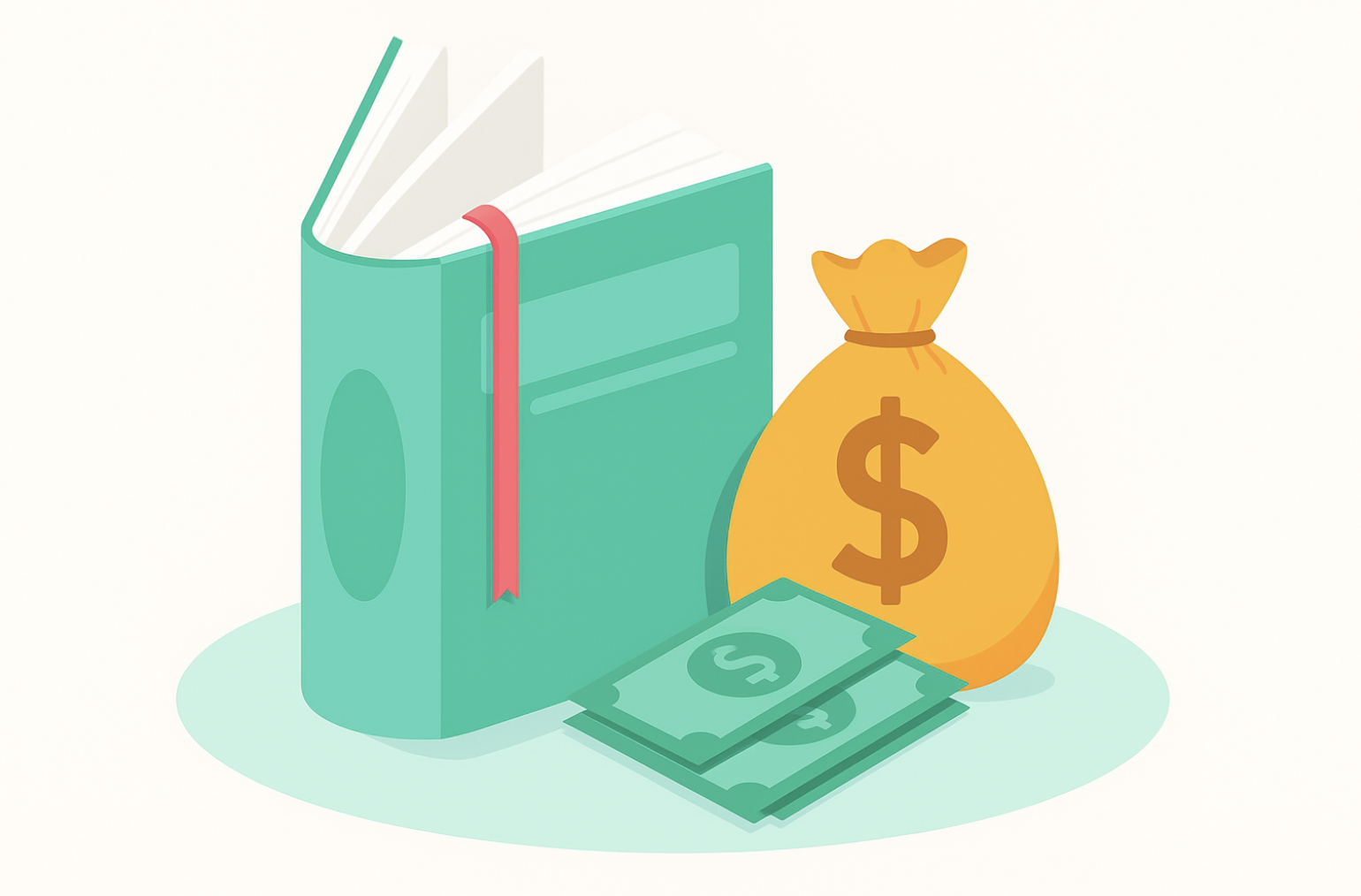In book publishing, publisher royalties are the payments authors receive from book sales, typically a percentage of the selling price or net receipts. These royalties vary based on factors like book format, contract terms, and the publisher’s policies.
Understanding publisher royalties is crucial for authors negotiating contracts and for publishers structuring fair agreements that attract talent while remaining profitable. Unlike music royalties—which include mechanical, performance, and synchronization royalties—book royalties focus primarily on physical books, eBooks, and audiobooks.
Publisher royalties in the book industry are essentially the author’s share of the proceeds from the sale of their book, paid by the publisher. These author royalties are a percentage of the book’s selling price or net receipts, agreed upon in the publishing contract. The structure and rate of these royalties can vary widely depending on several factors, including the book’s format (hardcover, paperback, eBook, audiobook), the author’s negotiating power, and the publisher’s policies.
The importance of understanding these royalties cannot be overstated for authors. This knowledge not only empowers authors during contract negotiations but also provides them with a clearer picture of their potential earnings This article will break down the key aspects of publisher royalties, helping authors and publishers navigate this essential part of the industry with clarity and confidence.
Your Publishing Journey Awaits – Start NowUnderstanding Different Types of Royalties
Moreover, in the realm of creative works, it’s easy to blur the lines between different types of royalties, especially when comparing book publishing rights to music publishing. While there are similarities in the concept of paying creators a share of the revenue generated from their work, the structures of these royalties diverge significantly due to the inherent differences in the products and industries.
In music publishing, royalties are more fragmented and can be categorized into mechanical royalties, performance royalties, synchronization royalties, and others, each pertaining to different uses of the music. Mechanical royalties, for instance, are paid for the physical or digital reproduction of a song, while performance royalties are generated when a song is played publicly. This complexity is compounded by the involvement of various rights organizations and licensing agreements.
Contrastingly to music rights, book publishing royalties are generally more straightforward, focusing primarily on the sale of physical books, eBooks, and audiobooks. There are no equivalents to mechanical or performance royalties in the literary world. However, like in music, there can be additional earnings from subsidiary rights, such as when a book is adapted into a film or translated into other languages.
Understanding Publisher Royalties
Publisher royalties, at their core, are financial remunerations paid to authors for the rights to publish, distribute, and sell their work. These payments are a pivotal element of the publishing contract and represent a percentage of the revenue and royalties generated from book sales. Unlike a salary or a one-time payment, royalties are ongoing, reflecting the continued commercial success of a book. They are the lifeblood of an author’s income from their writing, ensuring they receive compensation proportional to the sales of their work.
Distinguishing Royalties from Advances
To fully grasp the concept of royalties, it’s essential to differentiate them from advances. An advance is an upfront payment made to an author before the book is published, essentially an advance against future royalties. It’s a publisher’s bet on a book’s success, and it’s recouped as the book generates sales. Only once an advance is fully ‘earned out’ through book sales do authors begin to receive royalty payments. Therefore, while advances provide immediate financial support, author royalties represent the long-term earning potential of a book.
The Spectrum of Book Publishing Royalties
Royalties in the book industry are not one-size-fits-all; they vary widely and are influenced by the format of the book, the contract terms, and the publishing model. Understanding the different types of royalties is crucial for authors to gauge their potential earnings and for publishers to structure fair and motivating contracts.
Print Royalties
Print royalties are paid on the sale of physical books, including hardcovers and paperbacks. The rate is usually a percentage of the book’s list price (the cover price) or the net receipts (the actual sales revenue after discounts and returns). Hardcover royalties typically range from 10% to 15% of the list price, while paperback royalties are often slightly lower, reflecting the lower selling price and margins. The percentage can escalate based on sales milestones, encouraging authors and publishers to aim for higher sales volumes.
Digital Royalties (eBooks)
With the rise of digital reading platforms, eBook royalties have become a significant consideration. These royalties are often calculated as a percentage of net receipts, considering the digital nature of the product and the absence of physical production and distribution costs. Digital royalties tend to be higher than print, sometimes reaching up to 25% or more of net receipts. This increase reflects the lower overheads in eBook distribution and the industry’s standard practices, although specific rates can vary widely between publishers and platforms.
Audiobook Royalties
Audiobooks have surged in popularity, bringing audiobook royalties into the spotlight. These royalties are similar to eBook royalties in that they’re often based on net receipts due to the digital format. However, the production of audiobooks involves additional costs, such as narration, editing, and mastering, which can influence royalty earnings. Authors can expect audiobook royalties to range widely but generally fall within the realm of 15% to 25% of net receipts, with variations based on the publisher and distribution method.
Your Publishing Journey Awaits – Start NowThe Nuances of Royalty Calculations
Calculating royalties involves several key factors: the royalty base (list price or net receipts), the royalty rate, and the sales volume. For instance, a 10% royalty on a hardcover book with a list price of $25 would yield $2.50 per book sold. However, if the royalty is based on net receipts and the publisher sells the book to retailers at a 50% discount, the same royalty percentage would apply to $12.50 (the net receipt), resulting in a $1.25 royalty per book.
As the publishing industry evolves with new technologies and distribution channels, so too do royalty agreements. The rise of self-publishing platforms and digital distribution has introduced new dynamics in royalty structures, often allowing authors to retain a larger share of their digital book sales. Traditional publishers are also adapting, offering more competitive royalty terms for digital formats to attract and retain authors in a changing marketplace.
In conclusion, understanding publisher royalties is fundamental for authors and publishers alike. This knowledge ensures that authors can negotiate fair compensation for their work, while publishers can structure agreements that balance investment with reward. As the industry continues to evolve, staying informed about royalty structures and trends becomes even more crucial, shaping the future of publishing and the financial well-being of authors around the globe.
The Mechanics of Publishing Royalties
The calculation of publishing royalties is a nuanced process, governed by a variety of factors and defined within the contractual agreement between an author and a publisher. This section delves into the mechanisms of how royalties are calculated, the models used for their calculation, the structure of royalties, and the influences that can affect these rates.
Calculation of Royalties
At the heart of royalty calculations are two primary models: the retail price model and the net receipts model. Each model offers a different basis for calculating all the royalties still owed to an author, directly impacting the author’s income from their published works.
- Retail Price Model: In this traditional model, royalties are calculated as a percentage of the book’s retail or list price. This means the author earns a consistent amount per book sold, regardless of the selling price or discounts applied by the retailer. This model is straightforward but can sometimes be less favorable to authors, especially if books are heavily discounted.
- Net Receipts Model: Increasingly common, this model bases royalties on the net revenue the publisher receives from the sale of the book, after discounts, returns, and sometimes distribution costs are subtracted. This model aligns the interests of authors and publishers more closely, as both parties’ earnings are directly tied to the actual revenue generated.
Fixed Rate vs. Escalating Rate Royalties
Royalty rates can be structured in different ways within a publishing contract, with fixed and escalating rates being the most common structures.
- Fixed Rate Royalties: A fixed rate remains constant regardless of the number of copies sold. This simplicity offers predictability for both authors and publishers but might not adequately reward bestsellers.
- Escalating Rate Royalties: Escalating rates increase at certain sales thresholds, incentivizing both the author and publisher to maximize sales. For example, an author might earn 10% on the first 5,000 copies, 12.5% on sales between 5,001 and 10,000, and 15% beyond 10,000 copies sold. This structure rewards successful titles and acknowledges the author’s role in promoting their book.
Influencing Factors on Royalty Rates
Several factors can influence the determination of royalty rates, making each publishing deal unique such as Genre, Author Reputation, and Market Trends.
To illustrate how these factors come into play, consider the following case studies:
Case Study 1: J.K. Rowling and the “Harry Potter” Series
J.K. Rowling’s journey with the “Harry Potter” series is a quintessential example of how escalating royalty rates can reward the tremendous success of a book series. Initially, Rowling received an advance of £1,500 from Bloomsbury, a relatively modest sum reflecting her status as a first-time author.
As the “Harry Potter” series gained popularity, not only did her advances increase significantly, but her royalty commission likely escalated due to the series’ unprecedented sales. Given the series’ global sales exceeding 500 million copies, Rowling’s earnings from royalties alone illustrate the potential financial windfall from escalating rates in conjunction with high sales volumes.
Case Study 2: Stephen King and Digital Royalties
Stephen King, a prolific author known for his flexibility in exploring new publishing models, provides insight into digital royalty structures. In 2000, King released “The Plant” directly to readers in an electronic format, bypassing traditional publishers. He requested payments on the honor system, an unconventional approach at the time. This experiment highlighted the potential for high royalty earnings in digital publishing, where authors can retain a larger portion of sales revenue due to lower distribution costs.
In traditional publishing contracts, King, given his stature, would be positioned to negotiate digital royalties significantly higher than the standard 25%, possibly nearing 50% of net receipts, reflective of the more favorable cost structure of eBooks and the leverage held by established authors.
These case studies underscore the variability in royalty arrangements and the significant impact of an author’s commercial success and negotiating power on their earnings. J.K. Rowling’s escalating royalties with the “Harry Potter” series demonstrate how blockbuster success can lead to exceptionally favorable terms, while Stephen King’s foray into digital self-publishing exemplifies the potential for high digital royalty earnings afforded by the reduced costs of eBook distribution. Both scenarios highlight the importance of understanding and negotiating royalty terms that align with an author’s success and market trends.
Key Components of Publishing Agreements
Publishing agreements are multifaceted legal documents that delineate the terms of the relationship between an author and a publisher. Central to these agreements are clauses concerning royalties, rights and territories, and advances. Understanding these components is essential for authors to ensure they receive fair compensation and retain appropriate rights to their work.
Royalty Clauses: Navigating the Fine Print
Royalty clauses are arguably the most scrutinized sections of publishing agreements, defining how authors will be compensated for their work. Authors should pay close attention to several key aspects within these clauses including Royalty Rates, Format-Specific Rates, Escalating Royalties, and Reserves Against Returns. Publishers often hold a reserve fund from an author’s royalties to cover potential future returns by booksellers. The terms governing this reserve, including the percentage of sales held back and the schedule for releasing these funds to the author, should be transparent and reasonable.
Rights and Territories: Maximizing Global Potential
The rights and territories section of a publishing agreement specifies the scope of the publisher’s rights to publish and distribute the work. Key considerations include:
- Grant of Rights: Authors should understand which rights they are transferring to the publisher. These can include print, digital, audio, and subsidiary rights, such as film or foreign language translations. Retaining certain rights allows authors more control over intellectual property and the potential to earn additional income through other channels.
- Geographical Territories: This defines the geographical area in which the publisher can sell the book. Exclusive global rights can be advantageous for distribution but may limit the author’s ability to negotiate separate deals in different regions. Conversely, limiting the territory can allow authors to work with publishers in different markets who might be better suited to maximize sales in those regions.
- Subsidiary Rights: Authors should carefully consider which subsidiary rights they grant to the publisher and under what terms. Retaining some subsidiary rights, or ensuring a favorable split of income from these rights, can provide significant additional revenue streams.
Advances Against Royalties: The Initial Investment
Advances are upfront payments made to authors against future royalty earnings. While receiving an advance can be a significant financial boon for authors, understanding its implications is crucial.
Advances are not additional to royalties but are rather an advance on them. Authors do not start receiving royalty payments until the advance is fully ‘earned out’ through book sales. The size of the advance should be weighed against realistic sales expectations to avoid scenarios where royalties do not surpass the advance for an extended period.
The amount of the advance and the schedule for its payment (often split into portions paid on signing, manuscript delivery, and publication) can vary widely. Authors should consider their financial needs and the project’s timeline when evaluating these terms. And while a large advance is appealing, it’s important to consider the overall balance of the agreement. A smaller advance with higher royalty rates or more favorable terms in other areas of the contract might ultimately be more beneficial.
In conclusion, the key components of publishing agreements — royalty clauses, rights and territories, and advances — are critical in defining an author’s financial and creative relationship with their publisher. Authors must approach these clauses with a clear understanding and, where possible, negotiate terms that align with their career goals and expectations.
The Role of Literary Agents and Publishing Companies
In the publishing ecosystem, literary agents and publishing companies play pivotal roles, acting as gatekeepers and facilitators of the literary world. Their involvement can significantly impact the terms of publishing agreements, the distribution of a book, and ultimately, an author’s career trajectory. Understanding the dynamics between these entities, and their respective motivations, can offer authors valuable insights into the publishing process.
The Literary Agents
Literary agents act as intermediaries between authors and publishers, offering expertise in contract negotiation, industry knowledge, and strategic career planning. Their role in negotiating better terms for authors cannot be overstated.
Agents bring an in-depth understanding of publishing contracts and industry standards to the table. Their experience enables them to identify and negotiate better terms, including higher royalty rates, more favorable advance payments, and beneficial rights arrangements.
They must have a finger on the pulse of the publishing market, understanding which genres are in demand and what publishers are looking for. This insight allows them to position a book more effectively, potentially securing more competitive offers. Beyond a single book deal, agents consider an author’s long-term career. They can strategize over which rights to retain for future opportunities, ensuring an author’s work is leveraged in the most advantageous way across different markets and mediums.
The Publishers
Publishers, whether large or small, operate within a framework of risk and reward. Their primary goal is to publish books that are both culturally significant and commercially viable. The negotiation of publishing terms is a delicate balance of this principle:
Risk Assessment: Publishers evaluate manuscripts for their market potential, considering factors like genre trends, the author’s track record, and the book’s appeal. The terms offered in a publishing agreement reflect this assessment, with higher advances and royalties often correlating with perceived lower risk.
Investment in Success: Publishers invest significantly in a book’s production, marketing, and distribution. This investment informs their approach to contract terms, as they need to recoup costs before turning a profit. The terms must, therefore, ensure a fair return on investment while also providing sufficient incentive for the author.
Collaborative Relationship: Successful publishing requires a collaborative relationship between the author and publisher. Publishers may offer more favorable terms to authors they view as long-term partners, anticipating future works that will contribute to a mutually beneficial relationship.
Small Presses vs. Major Publishers
The choice between small presses and major publishers is a significant one, with each offering different advantages and implications for royalty terms:
Small Presses
Often more niche-focused and flexible, small presses can offer more personalized attention and may be more willing to take risks on unconventional works. They might provide higher royalty percentages, recognizing that lower print runs and potentially less market reach might necessitate a greater share of profits to attract and retain authors. However, their advances might be lower due to budget constraints.
Major Publishers
With their extensive distribution networks and marketing power, major publishers can potentially offer higher advances due to their larger financial resources. However, their royalty percentages might not be as high as those of small presses, given their broader infrastructure and higher overhead costs. The potential for a book to become a bestseller with a major publisher, though, can result in significant earnings over time, even at a standard royalty commission.
In navigating the complexities of the publishing world, authors must weigh the pros and cons of working with different types of publishers and the value of having a literary agent as an advocate and advisor. Understanding these dynamics is crucial for authors aiming to make informed decisions about their publishing journey.
Exploring Subsidiary Rights
Subsidiary rights in the publishing world refer to the rights to produce or use the content of a book in formats other than the traditional print and eBook versions. These rights can be a significant source of additional income for authors, extending the reach and impact of their work beyond the bookshelves.
Definition and Types of Subsidiary Rights
The sale and management of subsidiary rights can significantly affect an author’s overall earnings from their work. Each type of right represents a potential revenue stream, and when managed effectively, these streams can cumulatively surpass the income from book sales alone. Subsidiary rights encompass a wide range of potential uses and adaptations of a book’s content, including but not limited to:
- Foreign Rights: The rights to publish and distribute a book in languages other than the original. Selling these rights to foreign publishers can introduce an author’s work to a global audience, generating additional sales and royalties.
- Film and Television Rights: The rights to adapt the book into movies, TV shows, or other forms of visual media. These rights can be highly lucrative, especially if a book is successfully adapted into a popular film or series. It can often lead to new publishing opportunities and higher sales of subsequent works.
- Merchandising Rights: The rights to produce and sell merchandise based on the book’s content, characters, or themes. This can include anything from apparel and toys to stationery and home decor.
- Audio Rights: Separate from traditional audiobook deals, these rights might include adaptations for radio or dramatic readings beyond the scope of a standard audiobook format.
- Digital Rights: This can include a variety of formats, from interactive eBooks to apps and games that expand on the book’s content in digital spaces.
- Serial Rights: The rights to publish excerpts or serialized versions of the book in magazines, newspapers, or online platforms, often used as a promotional tool or to generate additional income.
Utilizing the benefits of these rights can provide opportunities for diversification of income as well as long-term earning potential. Subsidiary rights offer authors the opportunity to diversify their income sources, reducing dependence on direct book sales and providing financial stability through varied revenue streams. Many subsidiary rights, particularly in film, television, and merchandising, can provide long-term earnings well beyond the initial publication of a book, sometimes continuing to generate income years after the book’s release.
Collecting and Tracking Royalties
The process of collecting and tracking royalties is a crucial component of the financial relationship between authors and publishers. It ensures that authors are fairly compensated for their work based on the agreed-upon terms in the publishing contract. This section explores the publisher’s responsibilities, the importance of auditing and accurate royalty statements, and the role of digital tools in monitoring and collecting royalties.
The Publisher’s Role in Royalty Payments
Publishers are primarily responsible for accurately calculating and disbursing royalty payments to authors. This involves:
- Sales Tracking: Monitoring the sales of a book across various channels and formats, including retail stores, online platforms, and special sales, to determine the total revenue generated.
- Royalty Calculation: Applying the agreed-upon royalty earnings to the revenue figures, taking into account any returns, discounts, and other factors that might affect the net sales figures.
- Payment Disbursement: Issuing royalty payments to authors typically on a semi-annual or annual basis, accompanied by detailed statements outlining the sales figures and how the royalties were calculated.
This process requires a high level of diligence and accuracy to maintain trust and ensure that authors receive the payments they are entitled to.
Auditing and Royalty Statements: Ensuring Accuracy
Royalty statements provided by publishers should offer a transparent and detailed account of sales and the resulting royalties. Authors or their representatives should review these statements meticulously to ensure accuracy. Key components of a royalty statement include:
- Breakdown of Sales: Detailed information on the number of copies sold across different formats and channels, including any returns or unsold inventory.
- Calculation of Royalties: Clear explanations of how royalties were calculated based on the sales figures, including any escalations or adjustments applied.
- Deductions: Itemization of any deductions taken before calculating the net royalties, such as advances, reserves against returns, or other agreed-upon expenses.
Given the complexity of these statements and the potential for errors, authors sometimes opt for an audit of the publisher’s records. This is especially common when discrepancies are suspected or for high-stakes contracts where significant sums are involved. An audit can provide peace of mind and ensure contractual compliance.
Digital Tools and Services for Tracking Royalties
With advancements in digital technology, a variety of tools and services have emerged to assist authors and publishers in tracking royalties more efficiently. These include Royalty Management Software, Online Dashboards, and Third-Party Services. For example, with Self-Publishing platforms like Spines, a unified dashboard allows authors to monitor their royalties and performance across all these channels seamlessly. This comprehensive tracking ensures authors are always informed about their book’s reach and earnings.
Leveraging these digital tools and services can greatly enhance the accuracy and efficiency of royalty tracking, benefiting both authors and publishers by fostering transparency, trust, and a more collaborative partnership. As the publishing industry continues to evolve, the adoption of such technologies will likely become the standard, ensuring that authors are fairly compensated in a timely and efficient manner.
Challenges and Solutions in Royalty Management
Royalty management within the publishing industry is a complex and multifaceted process, fraught with challenges for both authors and publishers. Navigating these challenges requires a blend of clear communication, legal safeguards, and a willingness to embrace technological solutions.
Common Issues in Royalty Management
Authors and publishers often encounter several common issues in the realm of royalty management, including:
- Complexity of Sales Tracking: With books sold across multiple platforms, in various formats, and across global markets, accurately tracking sales to calculate royalties can be daunting. Discrepancies in sales figures can lead to disputes over royalty payments.
- Contractual Ambiguities: Vague or overly complex contractual terms can lead to misunderstandings about royalty earnings, payment schedules, and rights, complicating the royalty management process.
- Delayed or Inaccurate Payments: Issues with royalty calculations, sales tracking, or administrative errors can lead to delayed or inaccurate royalty payments, causing frustration and financial strain for authors.
- Changes in Market Trends: The rapid evolution of the publishing industry, including the rise of digital content and self-publishing platforms, introduces new challenges in managing and tracking royalties.
Dispute Resolution: Mediation and Legal Recourse
When disputes arise over royalties, resolving them amicably and efficiently is in the best interest of both parties. Mediation is often the first step, offering a less adversarial approach to resolving conflicts. This process involves a neutral third party who helps authors and publishers communicate their concerns and negotiate a solution. Mediation can preserve professional relationships and lead to quicker resolutions compared to litigation.
However, when mediation does not yield a resolution, legal recourse may become necessary. Authors might engage legal representation to review contracts, audit royalty statements, and, if warranted, pursue legal action to enforce contractual terms. While this route can be more confrontational and time-consuming, it sometimes is necessary to ensure fair treatment and compliance with the agreement.
The Future of Royalty Management: Trends and Innovations
Looking forward, the future of royalty management is poised for transformation, driven by trends and innovations aimed at addressing current challenges:
- Digital Royalty Platforms: Emerging digital platforms are streamlining the royalty management process, offering real-time sales tracking, automated royalty calculations, and transparent reporting. These tools can significantly reduce errors and discrepancies in royalty payments.
- Blockchain Technology: Blockchain holds promise for royalty management by creating transparent, immutable records of sales and transactions. This technology can facilitate automatic royalty payments, reducing delays and the potential for disputes.
- Smart Contracts: Built on blockchain technology, smart contracts can automate the execution of contractual terms, including royalty payments, once certain conditions are met. This automation can ensure timely and accurate payments, directly aligning with sales data.
- Data Analytics: Advanced analytics can offer deeper insights into sales trends, reader demographics, and market performance, informing more strategic decisions about book promotions and distributions, ultimately affecting royalty earnings.
Embracing these innovations can lead to more efficient, transparent, and fair royalty management processes, benefiting both authors and publishers. By leveraging technology and maintaining open lines of communication, the publishing industry can overcome current challenges and pave the way for a more equitable and prosperous future for all stakeholders involved.
Charting the Future: Navigating the Evolving Landscape of Royalty Management
The landscape of book publishing is in a state of constant evolution, shaped by technological advancements, shifting market trends, and changing consumer preferences. Digital platforms have revolutionized how content is distributed and consumed, offering new opportunities and challenges in tracking and managing royalties.
In this dynamic environment, the need for authors to be well-informed and proactive cannot be overstated. Understanding publisher royalties is more than just a matter of contractual obligation; it is a cornerstone of an author’s livelihood and recognition for their creative contributions. Knowledge of one’s rights, the nuances of royalty calculations, and the implications of various contractual terms is indispensable.
In conclusion, the journey through the world of publisher royalties highlights the importance of vigilance, education, and advocacy for authors. Authors, empowered by knowledge and fairness in their agreements, stand to not only enrich their own lives but also to enrich the cultural tapestry with their invaluable creative contributions.
FAQs – Publisher Royalties
Q: How long do publisher royalties last?
Publisher royalties typically last for the duration of the copyright, which in most cases extends 70 years after the author’s death. However, the length may vary based on contract terms and agreements between the author and publisher.
Q: Do you pay taxes on royalties?
Yes, royalties are considered taxable income. They are usually classified as self-employment or passive income, depending on how they are earned. Authors and rights holders must report royalty earnings and may need to pay income tax and, in some cases, self-employment tax.
Q: What is the difference between songwriter royalties and book publisher royalties?
Songwriter royalties are earned from the use of a song’s lyrics and melody. These royalties come from mechanical, performance, and sync licensing fees when music is sold, streamed, played on the radio, or used in films and commercials. The royalties are typically split between the songwriter and the music publisher.
Book publisher royalties are payments made to authors based on book sales and licensing agreements. Authors earn a percentage of each book sold, usually ranging from 5% to 15% for print books and 25% to 50% for e-books. Unlike songwriter royalties, book publishing royalties are mainly based on direct sales rather than ongoing usage rights.
Both involve rights management and revenue sharing, but songwriter royalties are tied to music performance and licensing, while book publisher royalties depend on book sales and distribution
Q: What does it mean to own 50% of publishing rights?
Owning 50% of publishing rights means you share control and earnings from licensing and royalties with another party (such as a publishing company). This affects revenue from mechanical, performance, and sync royalties, as you are entitled to half of the publisher’s share.
Q: Does it cost money to send a manuscript to a publisher?
For traditional publishers, submitting a manuscript does not cost money. However, self-publishing or hybrid publishing may require upfront fees for services like editing, formatting, or marketing. Be cautious of vanity publishers that charge high fees without offering real publishing value.
Q: How are publishing royalties calculated?
Publishing royalties are typically based on book sales, licensing agreements, and distribution channels. The standard royalty percentages are:
Print books: 5%–15% of the book’s retail or net price
E-books: 25%–50% of net revenue
Audiobooks: 10%–40% of net revenue
Music publishing: Varies between mechanical, performance, and sync royalties
The actual percentage depends on the author’s contract and whether they use a traditional, self-publishing, or hybrid model.
Q: How often do publishers pay royalties?
Publishers typically pay royalties quarterly or biannually, depending on the contract terms. Some publishers may issue payments monthly, but most follow a quarterly schedule, meaning authors receive payments every 3 to 6 months. The delay accounts for processing sales data, returns, and distribution fees before calculating the final royalty earnings.







